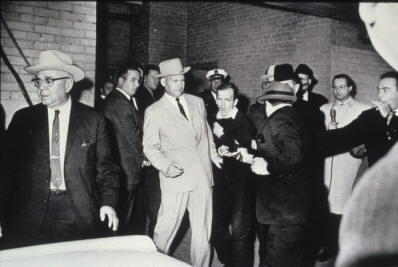Credit: Yale Collection of American Literature, Beinecke Rare Book and Manuscript Library
Alfred Stieglitz attached this photograph to a letter for Georgia O'Keeffe, dated July 10, 1929. Below the photograph he wrote, "I have destroyed 300 prints to-day. And much more literature. I haven't the heart to destroy this..."
Kathaleen Roberts / Journal Staff Writer
Wednesday, Aug 3, 2011
It was a relationship built on white-hot passion, nearly shattered on a fault line of freedom and creativity.
National Gallery of Art photography curator Sarah Greenough leafed through 25,000 pieces of paper exchanged by
Georgia O’Keeffe and Alfred Stieglitz to produce “My Faraway One: The Letters of Georgia O’Keeffe and Alfred Stieglitz, Volume I, 1915-1933,” (Yale University Press, 2011) an 800-page tome as big as the Chicago phone book. Despite its girth, the book represents just one-tenth of their correspondence during this period.
Greenough will be at the
New Mexico Museum of Art today to talk about the book.
When Stieglitz and O’Keeffe met in 1916, he was 52 and already considered the nucleus of the New York art world. She was an unknown 28-year-old Texas art teacher.
The book traces the pair’s correspondence –– hers in squiggles and curlicues, his in thick black lines –– across their relationship. Stieglitz became entranced by her work when introduced to it by O’Keeffe’s friend Anita Pollitzer. The couple frequently exchanged three to four letters a day. They were sealed, at O’Keeffe’s request, for 20 years after her death.
At first, O’Keeffe comes across as a smitten schoolgirl turned giddy by the attentions of a powerful man. Stieglitz, alternately charismatic, egotistical and narcissistic, yearned for a woman artist after spending years in a miserable first marriage.
“You can see them really starting to fall in love,” Greenough said.
Stieglitz, the man who had introduced Constantin Brancusi, Paul Cezanne, Henri Matisse and Pablo Picasso to the U.S., had long been searching for a great woman artist. He was convinced he had found one in O’Keeffe.
“In the early letters, you see him just getting to know her,” Greenough said. “I think he strongly wanted to encourage her art. Yet, eventually in the correspondence, his fascination with her as a woman artist gets transferred into his fascination of her as a woman.”
By 1916, Stieglitz was writing letters that were 20 to 30 pages long.
As O’Keeffe was about to return to Texas in 1917, he wrote to her: “How I wanted to photograph you –– the hands –– the mouth –– & eyes –– & the enveloped in black body –– the touch of white –– & the throat –– but I didn’t want to break into your time.”
Before O’Keeffe moved to New York in 1918, he wrote, “What do I want from you? –– Sometimes I feel I’m going stark mad –– That I ought to say.”
“They pretty much fell in love through their correspondence,” Greenough said.
Stieglitz found and cleaned a small studio for O’Keeffe. They began living together almost immediately and married in 1924.
By the mid-’20s, cracks start to snake through their bond. O’Keeffe desperately wanted a child; Stieglitz –– already the father of a daughter –– did not. She wanted to travel; he was a dedicated New Yorker. At first, the couple lived with Stieglitz’s brother and his wife. O’Keeffe later wrote that “living with the brother and the wife had all the emotional warmth of a cold, damp cellar.”
The family also intruded on her time to paint.
“And she wanted to live a more independent life than Stieglitz wanted her to,” Greenough said.
Thanks in no small part to Stieglitz’s promotion, O’Keeffe became a famous artist. Restless, she made the trip that would transform both their lives.
In 1929, O’Keeffe traveled to New Mexico to visit Mabel Dodge Luhan in Taos. She discovered a vast expanse of land and light that would flood her canvas. She was surrounded by a circle of artists and intellectuals, including Tony Lujan, D.H. Lawrence and Dorothy Brett.
“This really isn’t like anything you ever saw,” she wrote to Stieglitz from Taos in 1929. “Mabel’s place beats anything you can imagine about it –– it is simply astonishing.”
The letters offer glimpses of O’Keeffe’s take on her own paintings:
“I hate the back of my Ranchos church –– Tomorrow I must get out at it again –– It is heavy –– I want it to be light and lovely and singing.”
The cascading letters reveal the couple’s contrasting writing styles. Stieglitz’s is flowing and poetic, teeming with imagery. O’Keeffe paired phrases with squiggles and loops. “It’s almost as if she was … sketching out an idea.” Greenough said. “O’Keeffe is very lucid and very sharply rendered, like her paintings are distilled down to their essence.”
“Neither one of them cared about sending carefully crafted letters,” she added. “They’re very immediate and free-flowing.”
Greenough first met O’Keeffe through photographs –– the sparsely iconic black-and-white images by Stieglitz, the subject of the curator’s dissertation. Greenough organized one-man exhibitions of the acclaimed photographer at the National Gallery of Art. O’Keeffe asked Greenough to edit their correspondence. She annotated each letter with a “yes” or a “no” for publication.
“When I met her, it was an extremely different person than the one in the photographs,” Greenough said. “She had a very dry wit and a real twinkle in her eyes. She was definitely a strong-willed person.”
Greenough is at work on Volume II, which runs from 1934 to Stieglitz’s 1946 death.
“I think it probably won’t be nearly as long,” she said.
If you go WHAT: Sarah Greenough, author of “My Faraway One: The Letters of Georgia O’Keeffe and Alfred Stieglitz, Volume I, 1915-1933″
WHEN: 6 p.m. today
WHERE: St. Francis Auditorium, New Mexico Museum of Art, 107 W. Palace Ave.
COST: Free
CONTACT: 476-5088
Via The Albuquerque Journal
Related: NPR -
Stieglitz And O'Keeffe: Their Love And Life In Letters







